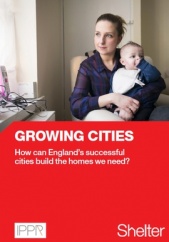Growing Cities, How can England’s successful cities build the homes we need?
Growing Cities, How can England’s successful cities build the homes we need?was published by by the Institute for Public Policy Research (IPPR) and Shelter in July 2015. It was written by Matt Griffith and Pete Jefferys and addresses ways in which England’s growing cities can build enough new homes to accommodate their success.
During 2014, IPPR and Shelter assessed four cities:
- York.
- Cambridge.
- Oxford.
- Bristol.
The report proposes that these are economically-successful mid-sized English cities that are being held back by chronic housing pressures, suggesting that if economically-buoyant areas cannot deliver new homes, there is little hope for the rest of the country.
It suggests that the key barriers to home building are; not enough land, and the wrong development incentives.
The report states, ‘Cities offer the clearest and strongest long term prospects of building more homes. In addition to political will, growing cities also have the underlying economic base to support a new approach to housing growth. They need better tools in their armoury to get more and better homes built on both brownfield and greenfield sites while commanding local popular support.'
The report cites; Lord Heseltine’s growth review, Labour’s Lyons Housing Review, the City Growth Commission, work by the Centre for Cities, and by URBED, the winners of the Wolfson Economics Prize 2014, and suggests that it is necessary to devolve powers and budgets to cities, recommending that:
- Councils within city-regions should be strongly incentivised to work closely together to co-ordinate building more homes.
- Strategic planning powers and budgets should be devolved to cities and resources such as public land should be pooled and coordinated across boundaries.
- Councils which block growth or refuse to co-operate should face financial penalties.
- Growing cities should be able to tax land that has planning permission but is being held back from being built, or built only very slowly.
- Where land with planning permission remains unbuilt, cities should have the backstop power to buy it with a compulsory purchase order, to incentivise market-led growth.
- Cities should be able to set up New Homes Zones on strategic sites which reduce land costs and therefore provide high quality, genuinely affordable homes.
- Cities should innovate with alternative models for development such as custom-build, based on national and international best practice.
- Cities should conduct green belt reviews to identify beautiful and publically-valuable land to protect, with active and democratic input from local people.
- Reviews should also identify low public value land, which is close to transport links and suitable for growth.
- Cities should be able to develop high-quality, green communities on low-value land, with ownership held in perpetuity by a Green Belt Community Trust.
Featured articles and news
RTPI leader to become new CIOB Chief Executive Officer
Dr Victoria Hills MRTPI, FICE to take over after Caroline Gumble’s departure.
Social and affordable housing, a long term plan for delivery
The “Delivering a Decade of Renewal for Social and Affordable Housing” strategy sets out future path.
A change to adoptive architecture
Effects of global weather warming on architectural detailing, material choice and human interaction.
The proposed publicly owned and backed subsidiary of Homes England, to facilitate new homes.
How big is the problem and what can we do to mitigate the effects?
Overheating guidance and tools for building designers
A number of cool guides to help with the heat.
The UK's Modern Industrial Strategy: A 10 year plan
Previous consultation criticism, current key elements and general support with some persisting reservations.
Building Safety Regulator reforms
New roles, new staff and a new fast track service pave the way for a single construction regulator.
Architectural Technologist CPDs and Communications
CIAT CPD… and how you can do it!
Cooling centres and cool spaces
Managing extreme heat in cities by directing the public to places for heat stress relief and water sources.
Winter gardens: A brief history and warm variations
Extending the season with glass in different forms and terms.
Restoring Great Yarmouth's Winter Gardens
Transforming one of the least sustainable constructions imaginable.
Construction Skills Mission Board launch sector drive
Newly formed government and industry collaboration set strategy for recruiting an additional 100,000 construction workers a year.
New Architects Code comes into effect in September 2025
ARB Architects Code of Conduct and Practice available with ongoing consultation regarding guidance.
Welsh Skills Body (Medr) launches ambitious plan
The new skills body brings together funding and regulation of tertiary education and research for the devolved nation.
Paul Gandy FCIOB announced as next CIOB President
Former Tilbury Douglas CEO takes helm.
UK Infrastructure: A 10 Year Strategy. In brief with reactions
With the National Infrastructure and Service Transformation Authority (NISTA).























